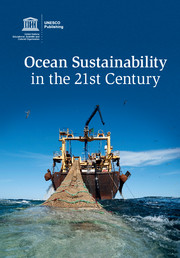Book contents
- Frontmatter
- Contents
- List of contributors
- Acronyms and abbreviations
- Foreword by Irina Bokova, Director-General of UNESCO
- Foreword by Thomas E. Lovejoy
- Preface
- Acknowledgements
- 1 Issues regarding oceans and opportunities: an introduction to the book
- 2 Main human uses of ocean areas and resources, impacts, and multiple scales of governance
- 3 Physical and chemical changes in the ocean over basin-wide zones and decadal or longer time-scales: perspectives on current and future conditions
- 4 Knowledge and implications of global change in the oceans for biology, ecology, and ecosystem services
- 5 A new perspective on changing Arctic marine ecosystems: panarchy adaptive cycles in pan-Arctic spatial and temporal scales
- 6 Ecosystem approach and ocean management
- 7 Challenges in using valuation in ecosystem-based management in a marine context: the case of UK Marine Protected Area designation
- 8 The contribution of international scientific cooperation and related institutions to effective governance for the oceans: the cases of regional tsunami early warning systems and the Argo project
- 9 Emerging and unresolved issues: the example of marine genetic resources of areas beyond national jurisdiction
- 10 The assumption that the United Nations Convention on the Law of the Sea is the legal framework for all activities taking place in the sea
- 11 The legal regime of outer space in light of the Law of the Sea
- 12 Towards sustainable oceans in the 21st century
- Index
- References
3 - Physical and chemical changes in the ocean over basin-wide zones and decadal or longer time-scales: perspectives on current and future conditions
Published online by Cambridge University Press: 05 May 2015
- Frontmatter
- Contents
- List of contributors
- Acronyms and abbreviations
- Foreword by Irina Bokova, Director-General of UNESCO
- Foreword by Thomas E. Lovejoy
- Preface
- Acknowledgements
- 1 Issues regarding oceans and opportunities: an introduction to the book
- 2 Main human uses of ocean areas and resources, impacts, and multiple scales of governance
- 3 Physical and chemical changes in the ocean over basin-wide zones and decadal or longer time-scales: perspectives on current and future conditions
- 4 Knowledge and implications of global change in the oceans for biology, ecology, and ecosystem services
- 5 A new perspective on changing Arctic marine ecosystems: panarchy adaptive cycles in pan-Arctic spatial and temporal scales
- 6 Ecosystem approach and ocean management
- 7 Challenges in using valuation in ecosystem-based management in a marine context: the case of UK Marine Protected Area designation
- 8 The contribution of international scientific cooperation and related institutions to effective governance for the oceans: the cases of regional tsunami early warning systems and the Argo project
- 9 Emerging and unresolved issues: the example of marine genetic resources of areas beyond national jurisdiction
- 10 The assumption that the United Nations Convention on the Law of the Sea is the legal framework for all activities taking place in the sea
- 11 The legal regime of outer space in light of the Law of the Sea
- 12 Towards sustainable oceans in the 21st century
- Index
- References
Summary
3.1 Introduction
Comprehensive international research programmes and reviews have firmly established that human activities are substantially impacting the total environment, including the ocean, and are triggering global and regional changes in the physical, chemical, and biological conditions which affect ecosystems and human societies. These programmes include the International Geosphere–Biosphere Programme (IGBP), the Large Marine Ecosystem Programme (LME), activities of the Intergovernmental Oceanographic Commission (IOC) and World Heritage Convention of UNESCO, as well as integrated assessments of the Intergovernmental Panel on Climate Change (IPCC) and the United Nations Environment Programme (Kullenberg, 2010; Clarke, 2010).
As a consequence of the growing needs of the increasing human population, diverse pressures on the marine environment have increased markedly over past decades. These include offshore oil and gas exploration and exploitation (e.g. into deeper and more hazardous areas of the Arctic Basin), expansion of fisheries into new areas (e.g. the Southern Ocean krill fisheries), transportation and shipping (e.g. across previously ice-covered areas of the Arctic Basin), offshore extraction of renewable energy, aquaculture production, enhanced use of the coastal zone for urbanization, land reclamation, infrastructure installations, ports and transportation, and recreation and tourism. Taken together these factors constitute a global change parallel to the population growth since the 1950s, with large consequences for our physical environment. However, what of all these factors constitutes significant change? Carmack and McLaughlin (2011) conclude that ‘changes in the physical environment are considered significant when they affect the biosphere, including humans’. This definition agrees in principle with the IGBP and LME approach. Observations and model simulations show that impacts of climate change on the ocean include the redistribution of oceanic water mass boundaries and habitats, and identify the need for time-series observations over a wide range of ocean zones that will permit science-informed policy decisions.
In the present chapter we briefly summarize documented changes and variations in the physical, chemical, and biological nature of the marine environment over basin-wide zones and decadal or longer time-scales, omitting any in-depth analysis of possible consequences for biology and the ecosystem.
- Type
- Chapter
- Information
- Ocean Sustainability in the 21st Century , pp. 54 - 83Publisher: Cambridge University PressPrint publication year: 2015



